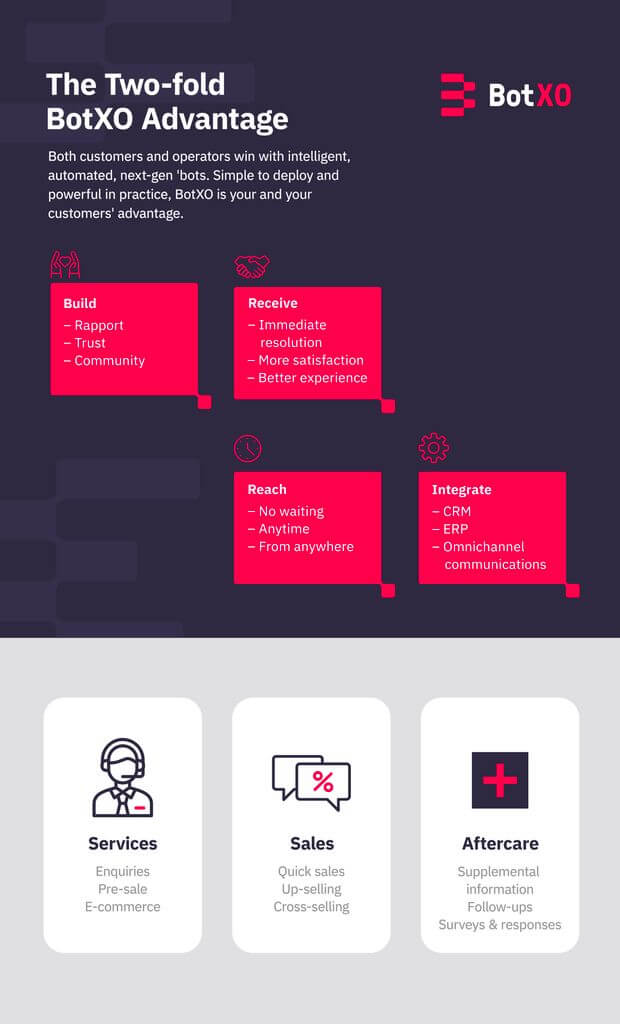The next-gen BotXO bots that learn, help, and inspire customers online
Every retailer knows the benefits of training their shop floor staff properly. Well-versed in the product lines, capable of intelligently recommending items, always polite and helpful — these are the attributes of staff that will actively drive sales and customer satisfaction.
The situation online is somewhat different, however, despite the same products and services being available in an app or on the web as right there on the sales floor. There are no helpful store assistants to guide shoppers, yet online shopping this holiday season will be especially busy: think of the busiest peak period, then double it!
As busy at this period might be, online there’s no human element to the customer experience (although in some cases, that’s an expressed preference). But until the emergence of a new breed of technology called “conversational commerce” (see our previous article in this series right here), there would have been no alternative other than for a customer than to plough on alone.
What conversational commerce offers is intelligent, helpful and expert digital assistants to help out — if required — at all stages of the customer journey. Forget your notions of the bots you see in many apps or websites. Those are designed to try and help organisations not lose any customers by engaging with them until a human operator can be located. Because of the limits of the tech that programmed them, they offer little to increase the quality of the customer experience and are often — and probably quite rightly — ignored.
Smart conversational commerce technology represents the next generation of online assistants, ones that are capable of following conversations and queries from prospective customers, engaging proactively during the sales process, completing sales and taking payments, and providing customer support services further down the line, if needed.

BotXO
And because the algorithms are both creative and have access to all an organisation’s data, their knowledge both widens and deepens over time. The core of the conversational commerce facility is based on artificial intelligence, so can ingest vast quantities of data from pre-sales databases like CRM systems or marcoms. Conversational Commerce, systems work alongside webshop tech (like Magento or Shopify) and back end systems (Zendesk, Freshdesk and so on), drawing data from wherever it happens to be.
When a prospective browser fires up an app or lands on a website, the AI-powered bot will know (thanks to those integrations) what have been the most valuable first contacts in the past, and what special offers are being pushed by Marketing. Plus, thanks to the deep integration with other systems, it might know stock levels intimately, when stocks will be replenished, and what is or isn’t available right at that moment.
This type of functionality means that data flows seamlessly from lead generation processes, through prospecting, engagement, sale and customer retention. The same technology powers any number of bots at any or all stages of the customer journey, and helps boost sales and turn customers into brand advocates.
Removing historical bot immunity
Anyone who has used Amazon or Netflix will be well-aware of the “if you enjoyed X then you might also like Y” factor that either appears as discrete suggestions on a page or actually drives choices being presented in real-time. While facilities like these are useful, they are also inherently uncoordinated. They fail on at least two common grounds: purchase of gifts and purchase of expensive, long-term goods or services.
A customer is unlikely to want further recommendations for a lawnmower or mortgage if they transacted yesterday, but that’s just the sort of reality that skews ‘traditional’ preference algorithms. In the same way, a fashion-conscious millennial may buy an elderly, austere relative a gift, but will be unlikely to do so more than a couple of times a year — yet ‘helpful’ bots continue to suggest unlikely purchases seemingly forever!
In many cases, customers develop an immunity to what are seen as annoying interventions. It’s therefore imperative that, when engaged, conversational commerce-driven entities hit the spot and add, proactively, to the customer experience. This new breed of technology is upgrading the concept of virtual assistants:
“Out of stock” becomes “Unfortunately not available in that colour until next Tuesday. Would you like to see a similar shade, same size?”
“Learn more” becomes “Here’s more on the offer you’ve seen on Facebook this week.”
“Go to checkout” becomes “This accessory would work well, and it’s in your budget!”
Cross-departmental benefits
The in-store assistant who brings value to the organisation is helpful, informed and actively encourages engagement. With conversational commerce, intelligent technology performs the self-same role, driving up the quality of the app’s or website’s user experience on offer.
But unlike the specialist sales advisor, the new generation of ‘bots works across departments and divisions in every part of the business: from Operations, through Marketing, E-commerce, Sales and Customer Service.
Driven from the same broad base of data, ever-improving and always available, the conversational commerce silicon assistant makes the online or in-app experience as rich and personalised as the in-store. In many ways, however, the bot exceeds the capabilities of its human colleague: a jack-of-all-trades and a master of them, too.
To learn more about this exciting new area of highly integrated, smart technology that’s making change occur in organisations like yours all over the globe, learn more from this informative eBook, from the award-winning pioneers of this technology, BotXO.
As organisations struggle to differentiate themselves in terms of quality of product, difference in price point, or overall richness of customer experience, a new generation of technological helpers are helping to create positive distinctions at every waypoint in the customer or prospect’s journey.









